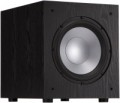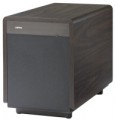Phase inverter location
—
Behind. It is recommended to install subwoofers with a rear bass reflex so that the back of the case, where the bass reflex is located, is away from the wall. If you put such a subwoofer right next to the wall, then the sound quality will be noticeably reduced. Bass reflex subwoofers on the back of the cabinet are usually placed in the centre of the room. If it is not possible to put acoustics in the centre, then they try to place this type of subwoofers away from the wall that the bass reflex is looking at.
—
Front. Front-facing bass reflex subwoofers are good if the acoustics need to deeply reveal the image of low-frequency sound. Acoustics of this type are recommended for music in which there is a lot of bass. The front location of the phase inverter allows you to put the subwoofer almost close to the wall.
—
From below. Bass reflex subwoofers are designed to be hung at a height. In this case, there will be no interference in the path of low-frequency sound, that is, the bass will be revealed as fully as possible. If it is not possible to hang such a subwoofer, then it is permissible to put the acoustics on a high stand. But the stand should not overlap the phase inverter.
—
Sideways. Subwoofers with a side bass reflex can be placed close to the wall and in the corner, but if the corner wall does
...not block the bass reflex. The lateral location of the phase inverter allows acoustics to focus on mid-frequency and high-frequency sound. The low frequency sound will become moderate. This is the optimal acoustic scheme for watching movies.Power
Rated power of the subwoofer. Technically, this is the highest average (rms) sound power at which the device can work normally (without sound distortion and damage to components) for an unlimited time. Simply put, the more powerful the subwoofer, the louder it is. The choice for this parameter depends primarily on the size of the space / room that is planned to be covered; detailed recommendations for different situations can be found in special sources.
Also, the power is directly related to the characteristics of the amplifier used with the subwoofer. For active subwoofers (see "Type"), this item actually indicates the nominal power of the built-in amplifier; the speaker itself can be more powerful, but it doesn't matter anymore. For passive models, the power rating corresponds to the highest amplifier power that can be connected to the speaker without the risk of damaging it at high volume.
Frequency range
The range of audio frequencies reproduced by the subwoofer. As a general rule, the wider the frequency range, the richer the sound and the more detail the speaker can convey. However, it is worth remembering that subwoofers as a class are designed for low and ultra-low frequencies in the range from 20 to 150 (sometimes 200) Hz. Therefore, in fact, a significant difference in sound is noticeable only with a large difference in the reproducible ranges (for example, 20-200 Hz and 50-150 Hz).
Also, do not forget that an extensive frequency range is not yet a guarantee of high-quality sound; and in some cases (for example, if the main speakers of the speaker also cope well with low frequencies), it may be completely redundant.
Speaker size
The diameter of the speaker(s) installed in the subwoofer.
It is believed that the larger the speaker (
15 ",
18 " and more), the more power it can produce and the deeper the bass will be on such acoustics. However, in modern subwoofers, manufacturers use various tricks that allow achieving good sound depth even with relatively small speaker sizes (
10 ",
8 "). Therefore, it is possible to compare different models only if they differ significantly in this indicator; and even then, in such cases, it is worth paying attention not so much to the speaker diameter as to the price category. The golden mean among sizes is
12-inch subwoofers.
Crossover frequency
Cutoff frequency of the crossover installed in the subwoofer (or supplied with it — for passive models, see "Type").
The crossover splits the audio signal into separate frequencies so that only the bass goes to the subwoofer and only the main range goes to the speakers. Such a device is mainly equipped with home models (see above). And the crossover frequency is the upper threshold of the frequencies fed to the subwoofer. This information is important for matching with the rest of the speakers: ideally, the lower threshold of the main acoustics should correspond to the upper threshold of the subwoofer, otherwise the frequencies will either overlap or dip in them (neither of which contributes to sound quality). For the convenience of matching, the crossover can be made adjustable (see above).
Outputs
—
RCA (linear). A standard interface for handling analogue audio from a preamplifier. In subwoofers, it is used to transmit a signal to other acoustic components, mainly in home models (see "Intended Use"), designed to build 2.1 systems. Usually, such a signal is pre-processed by a built-in crossover, which “selects” the bass frequencies for the subwoofer and outputs only the midrange and treble; however, in some models, direct switching of the audio signal is also possible, without separation into frequencies. In linear RCA, each channel of audio needs its own jack; accordingly, for the mentioned 2.1 systems, a pair of connectors is usually provided for one output.
—
RCA (LFE). The LFE interface is designed to work with a low frequency signal (bass). The presence of such a connector is useful, first of all, if you need to use a second subwoofer — not all players, receivers and other signal sources have enough of their own outputs for this, and it’s closer to pull the wire to the first “subwoofer”. Note that the second subwoofer must be active, otherwise it will require an additional amplifier.
—
Jack (6.35 mm). Socket for 6.35 mm Jack. This connector is mainly used in professional audio equipment, it can be used both for a linear signal and for a signal from a power amplifier. The output is intended for switching such a signal to other acoustic compon
...ents. The 6.35 mm jack provides good connection quality, connects and disconnects quickly (although the lack of a lock slightly reduces reliability), and can also be used for balanced audio (see "Balanced XLR" below), although support for this function in each individual case should be clarified separately.
— Balanced XLR. Characteristic round plug with 3 pins and lock. It is similar in purpose to the RCA line output described above (including the “1 channel per plug” principle), except that XLR is used mainly in professional audio equipment, and the connection is made in the so-called balanced format. Its peculiarity lies in the fact that due to the specific method of signal transmission, the cable itself plays the role of an interference suppressor, which allows the use of rather long wires without compromising the purity of the sound. Because of this, as well as the reliability of the connection, the XLR has become very popular in high-end equipment, including studio and live.
— Speakon. Professional connector designed to work with a signal from a power amplifier. Specially designed for high power sound, based on the reliability of the connection and the maximum protection of people from touching the contacts, and is used mainly in concert technology. Like any audio output, Speakon is used for signal switching (including connecting a passive speaker to a subwoofer amplifier, see above), while some subwoofer models may have built-in crossover processing.
— High-level (terminals). Interface for working with a signal from a power amplifier, normally used in home acoustics. The high-level output is often paired with a corresponding input and used to route an external audio signal from a power amplifier; while the sound is usually processed by the built-in crossover. There are also active subwoofers that can play the role of an external amplifier for passive acoustics and supply the terminals with an audio signal received from the line input and “swung up” to the desired power; see "Connecting a Passive Speaker" for details.Material
- MDF. Medium-density fiberboard is one of the most popular materials for modern speaker cabinets, including subwoofers. This is due, on the one hand, to the relatively low cost and neat appearance, and on the other hand, to excellent acoustic characteristics.
MDF cases are found in “subs” for all purposes and price categories.
- Tree. Natural wood is well suited for low-frequency acoustic enclosures; its performance characteristics are comparable to MDF described above. At the same time, this material is considered more “natural” and has its own beautiful surface pattern, but is noticeably more expensive. Therefore, although
wooden cases are common, they are not as widespread as MDF.
- Plastic. The main advantage of plastic is its low cost, but it is very difficult to create a body with the necessary acoustic characteristics from this material. Therefore,
plastic subwoofers are extremely rare, mostly built-in models.
- Metal. In this case, we mean various alloys and aluminium models. The metal is highly durable, but the acoustic characteristics are far from optimal. This requires the use of various tricks, which respectively affect the price
of a metal subwoofer. Therefore, this option is quite rare.

